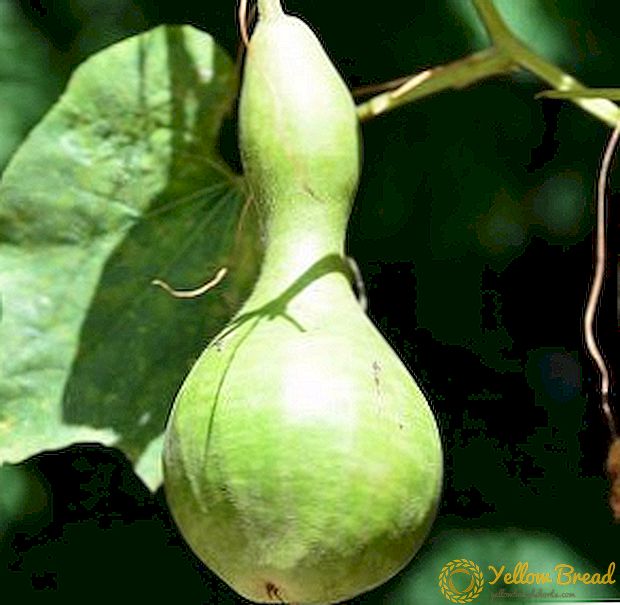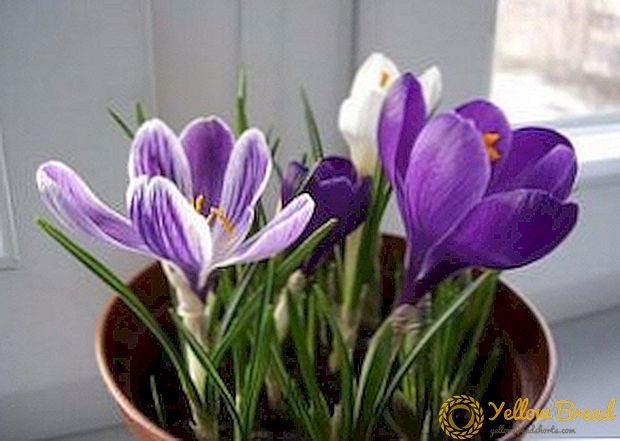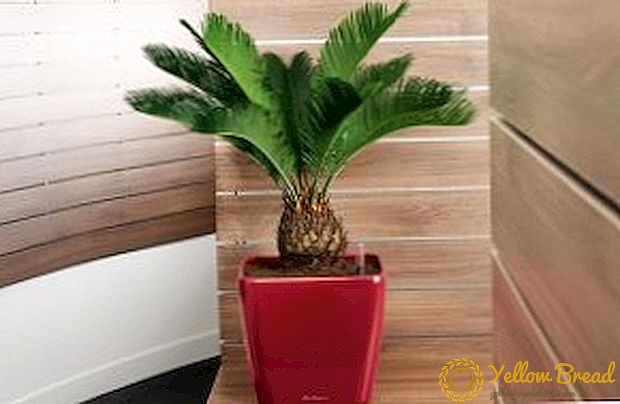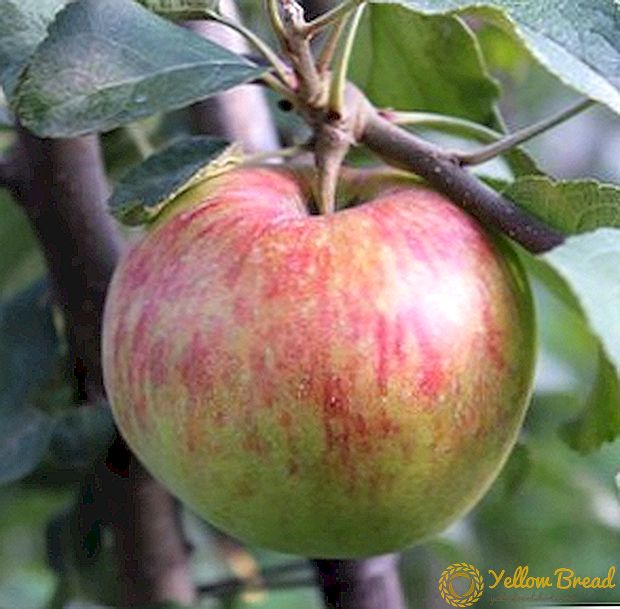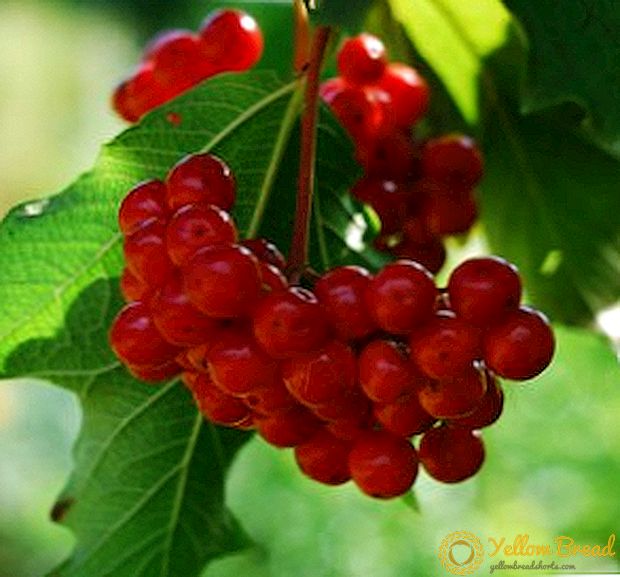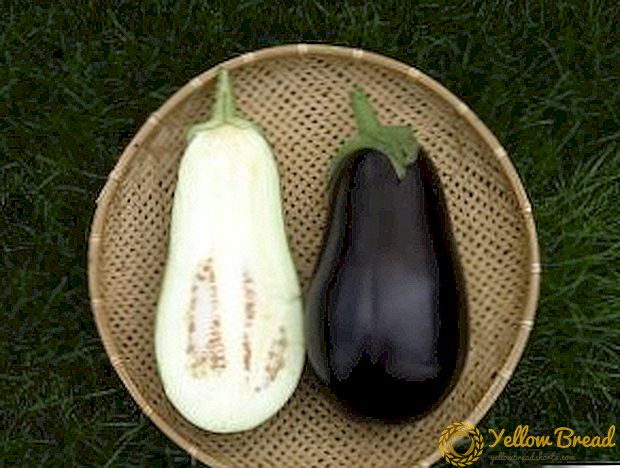
Eggplant hybrid variety "Epic F1" on domestic suburban areas known not so long ago, but over a fairly short period, this plant has proven itself well. This brand new hybrid has an unprecedented yield and size of its fruit. In addition, the relatively short growing season of the plant makes it possible to grow it not only in the southern regions, but also in colder climates.
- Description and photo of a hybrid
- Bushes
- Fruit
- Characteristic and taste
- Advantages and disadvantages
- How to sow eggplant seedlings
- Soil and Seed Preparation
- Sowing scheme
- Seedling care
- Planting direct seeding
- Grade Care
- Watering and soil care
- Top dressing
- Spraying disease
- Collect and store the harvest
Today we will talk about all the features of this fruit species to help gardeners grow a decent crop of eggplants.
Description and photo of a hybrid
Despite the general similarity of the variety with other representatives of this group of plants, it has some features that qualitatively distinguish this eggplant from other varieties. Let us consider in more detail the most important features of the hybrid.
Bushes
Mature bush in a hybrid is quite powerful and solid, the stem at the same time reaches a length of about 1 meter, erect and semi-sprawling. The power of growth of the bush in this eggplant has a high energy. In addition, the stem is characterized by medium pubescence and is characterized by a characteristic color, in which green colors predominate with a slight shade of red, blue or purple tones. The leaves are small, mostly medium in size, bright green in color.

Fruit
Fruits of a grade "Epic" quite large, in a form cylindrical. Their average length is about 22 cm, and the width is 10 cm. The mass reaches 200-230 g. However, there are fruits of much larger sizes, this primarily depends on the climatic conditions, the soil and the amount of fertilizers applied. The color of eggplant is characteristic: it is dominated by dark purple hues, the structure of the skin is glossy. On the cup there are rarely located spikes.The flesh is white in color and dense in structure.
Characteristic and taste
"Epic" refers to the early ripe fruit plants, The growing season in natural conditions is about 65 days, but, in some cases, this period can last up to 80 days. The variety was bred not long ago, thanks to the efforts of Dutch breeders from the company "Monsanto". Eggplant is intended for cultivation in the open field in a subtropical climate, however, the plant is suitable for growing and fruiting in the greenhouse conditions of the temperate zone. In addition, unlike many competing varieties, "Epic" is resistant to the enemy of all the nightshade - the tobacco mosaic virus.

Eggplant fruits have excellent taste characteristics. First of all - this is the complete absence of bitterness and increased flavor. The variety is ideal for use in both fresh and canned form.From this, its taste characteristics only increase.
Advantages and disadvantages
The majority of amateur gardeners and professionals speak positively of the Epic F1 variety. The main advantages of this vegetable are:
- High immunity of the plant organism to the tobacco mosaic virus and most other diseases.
- Excellent resistance to sudden temperature fluctuations.
- Increased taste.
- The hybrid is great for diets, as its fruits contain low amounts of fat and a high concentration of vegetable protein, potassium, and many vitamins.
- The fruits of the plant are perfectly amenable to preparation, while their processing is not difficult, and the resulting products are of excellent quality and culinary characteristics.
- In growing and caring eggplant "Epic F1" unpretentious, in addition, agrotechnical features are so simple that even a beginner can cultivate this vegetable on its plot.
- Increased productivity of the bush, which averages 5.8 kg per 1 square. m

But there is this agricultural plant and disadvantages. These primarily include:
- Insufficient winter hardiness. The plant is adapted mainly for cultivation in a warm southern climate.
- Cultivation in open soil provides for the cultivation of seedlings, which complicates the overall process of obtaining fruits in colder regions.
- Eggplant shrubs require a garter without fail, since large fruits under their weight can damage the stem.
- At home, the fruit does not retain freshness for a long time.
How to sow eggplant seedlings
Every gardener at least once in his life tried to grow eggplant in his own summer cottage, as this plant is one of the key products in the daily diet of most people in our region. But many have encountered difficulties that have plagued the cultivation of this variety. Therefore, below we will reveal all the secrets of growing this vegetable at home.
Soil and Seed Preparation
Seeds before sowing need disinfection. This procedure is carried out in order that the appeared sprout is not subjected to fungal diseases. For disinfection use 2% manganese solution, in which you need to immerse the seed and incubate for 20 minutes. In order to prepare this solution, you need to dissolve 2 g of potassium permanganate in 100 ml of water. After the procedure, the seeds are washed in cold boiled water and lightly dried on a sheet of paper or cut fabric.

You can also disinfect seeds with hydrogen peroxide. To do this, dissolve 3 ml of peroxide in 100 ml of water, heat the solution to +40 ° C, after which the seeds are soaked for 10 minutes. If you have purchased specially prepared seed - it does not need disinfection. This is indicated by the manufacturer on the packaging.
For seeding using a special, prepared in advance, the substrate, which must have a sufficient amount of all the nutrients. For these purposes, the best choice will be a special soil for seedlings, which can be bought at any garden store. Also, many gardeners use for this purpose a special substrate prepared with their own hands. In this case, the soil for planting is made in two ways.

In the first case, a simple fertile soil from the dacha is cleaned of excess vegetation and impurities, and then mixed in equal parts with sand and substrate for houseplants. In the second case, the soil from the garden can be replaced with peat, which in equal parts is mixed with sawdust and a substrate for seedlings. In addition, the soil for seedlings can be enriched with potassium, urea, turf or superphosphate. Substrate can be any, at your discretion. The main thing that should be remembered in its preparation: eggplants love fertile, loose, light soils that are additionally enriched with mineral, organic fertilizers or their mixtures.
Sowing scheme
Sowing seeds for seedlings spend approximately the first half of February. This is necessary to ensure that the plant is finally formed for flowering and fruiting, but depending on the climatic characteristics of the region, these periods may vary in one direction or another. Prepared substrate tightly stuffed in garden utensils. For these purposes, you can use special garden cassettes for seedlings, plastic cups, a common container or any other container to choose from.

Next, the substrate must be abundantly moistened, after which the seeds are sown and covered with a layer of soil no more than 1 cm. After sowing, the container is wrapped in a transparent plastic wrap and put in a warm place for germination. It will also be useful to moisten the seeds and soil with melt water. For these purposes, seeds are sown in a dry soil, after which the whole structure is covered with snow. After it has melted, the seeds can be covered with foil and germinated in a warm place. This procedure is quite effective, since in this case, the sprouts are more immune to environmental conditions.
Seedling care
Care for eggplant seedlings "Epic" does not imply any particular difficulties. Capacity with seeds, which is covered with a film, put in a warm place with a constant temperature not lower than +25 ° C. After 7-10 days, the first shoots appear, after which the film must be removed and the temperature of the seedlings gradually lowered to + 16-18 ° C. After some time, it can be raised to +25 ° C during the day and lowered to + 13-15 ° C at night - this method will help the plant to better prepare for planting in natural conditions.

Irrigation is carried out moderately, as the seedlings can get sick and die. Best of all for this purpose suitable rainwater, in its absence, you can use distilled tap water. In addition, do not forget about plant nutrition. The first procedure should be carried out a week after germination, for these purposes use fertilizers with a high content of phosphorus. Then, every 7-10 days before transplanting into open soil, eggplant sprouts can be fed with special fertilizers to speed up the growing season.

Care must be taken to ensure proper lighting. The natural duration of daylight will not be enough for these purposes, therefore, the shoots must be artificially highlighted.For these purposes, any room fluorescent lighting is suitable, but it is best to take care of the availability of a special fitolamp. A light day should last at least 12 hours a day, for this the time period is suitable from 7 am to 7 pm. It is necessary to dive eggplants only in the case when a small capacity for germinating seeds was initially chosen, or with a strong plant density per 1 square meter. see. In this case, with the development of 2-3 true leaves, the shoots are transplanted into a separate container at least 10-12 cm deep.
Planting direct seeding
Planting direct sowing of eggplants is carried out only in the conditions of the southern climate., as in colder regions, this variety will not have time to begin to fully bear fruit before the onset of autumn cold weather. In order to sow the seeds, it is necessary to pre-fertilize the soil with organic and mineral fertilizers in the amount of 0.5-1 bucket per 1 sq. M.m of humus, then add 40 g of phosphorus-potassium fertilizer and 50 g of nitroammofoski per 1 square. m, you also need to prepare the seeds and the method described above.

Cultivation in this way is best carried out in greenhouse conditions, and in the absence of this structure in your area, the soil should be covered with plastic wrap. The distance from the ground to the dome of the structure should reach 30-50 cm, this is achieved due to the tension of the dome on the prepared metal arcs of dense wire.

In such conditions the plant requires constant watering and feeding, the soil in the greenhouse should be slightly moist. In addition, after the emergence of the first seedlings need to fertilize liquid fertilizer to accelerate the growing season. After the plants are formed and the temperature regime allows them to transplant, the seedlings need to dive to a permanent place. For this plant is quenched. The process is to gradually open the dome for an increasingly long time, followed by its removal. To do this, airing should be increased smoothly, starting from 1 hour per day.
Grade Care
In order to care for eggplant, complex agrotechnical techniques from the grower is not required, but due to the fact that the view is rather capricious, there are a number of technological features that will help grow a healthy fruit-bearing plant. Next we have to consider the most important of them.
Watering and soil care
In order to provide optimum soil conditions for eggplants, the soil needs compulsory and constant care. To do this, throughout the season it is necessary to destroy weeds and to ensure constant loosening of the soil. As a result, the quality and quantity of the crop increases several times. In addition, in order to achieve abundant fruiting, eggplant plants need to be watered. This procedure should be carried out at least 1 time in 2-3 days, and during the period of active ripening of fruits, watering is carried out daily.For these purposes, it is recommended to use warm water, which is preheated to a temperature of at least +20 ° C.
Top dressing
Top dressing is one of the main conditions for high yield, so this procedure should be carried out at least 3-5 times per season. The first dressing is carried out 2 weeks after transplanting the seedlings into open soil, since until this time the weak root system of the plants has not absorbed the beneficial substances. Further, the number of dressings is at the discretion of the gardener, the main thing is to carry out fertilization at intervals of several weeks. In addition, it is necessary to feed the plant with additional elements before flowering, as this will not only speed up the process, but also double the number of ovaries.

Prior to fruiting, the best fertilizing will be complex fertilizers in mineral form. But during the fruiting period, it is best to replace them with a nitrogen-phosphate mixture. To prepare it in 10 liters of water dissolve 1 tsp. nitre and 1 tsp. superphosphate. The resulting mixture is used for abundant watering of the soil.

Spraying disease
Despite the fact that the variety is quite resistant to many diseases, the bushes of eggplants should be treated with chemical means of protection if possible. Today, there are several universal substances that help protect the plant from such diseases as: late blight, gray rot, bacterial spotting, black leg. These include solutions of Bordeaux liquid, cuproxate, copper sulphate, etc. The eggplant treatment system includes spraying the plants as soon as 3 weeks after the emergence of full seedlings, and the eggplant bushes must be treated several weeks after planting on a permanent place.
Collect and store the harvest
The technical maturity of eggplants occurs on average 25 days after flowering. Signs of a ripe fruit are: its characteristic dark purple hue, a glossy glow of the skin and elasticity of the pulp. It is important not to overdo the fruit, because otherwise they will over-mature, become less elastic and lose taste characteristics (a strong bitterness will appear, the flesh will become hard).But tearing green fruits is also not recommended, as they are not sown when ripped off.

Due to the fact that the fruits of eggplant ripen unevenly, harvesting takes place gradually and only selectively. It should not be forgotten that you need to visit the garden for fresh fruit at least once every 2-3 days. It is worth remembering that during the removal of the fruit from the bush, it is necessary to leave about 3 cm of the stalk on the shoot, this will help reduce the stress exerted by the person on the plant organism.

+1 ° C in 1 layer. After 3 weeks you need to conduct an audit, damaged and spoiled eggplants are rejected for cooking or preservation.
Healthy fruit wrapped in paper, laid out on the straw in a single layer,then covered with sacking. In this form, in a cool cellar eggplant will last until late autumn. But if it is planned to keep the vegetable for no more than 3 weeks, any cool place in the house (refrigerator, balcony, etc.) will do for this.
Hybrid eggplant "Epic F1" is the best choice for the summer cottage, as the plant does not require complex care, but it is characterized by high quality fruits. In addition, this vegetable is not only an important part of the daily diet, but also a real source of useful and important substances for the human body. Using the above recommendations, you can achieve a high yield of eggplant.

